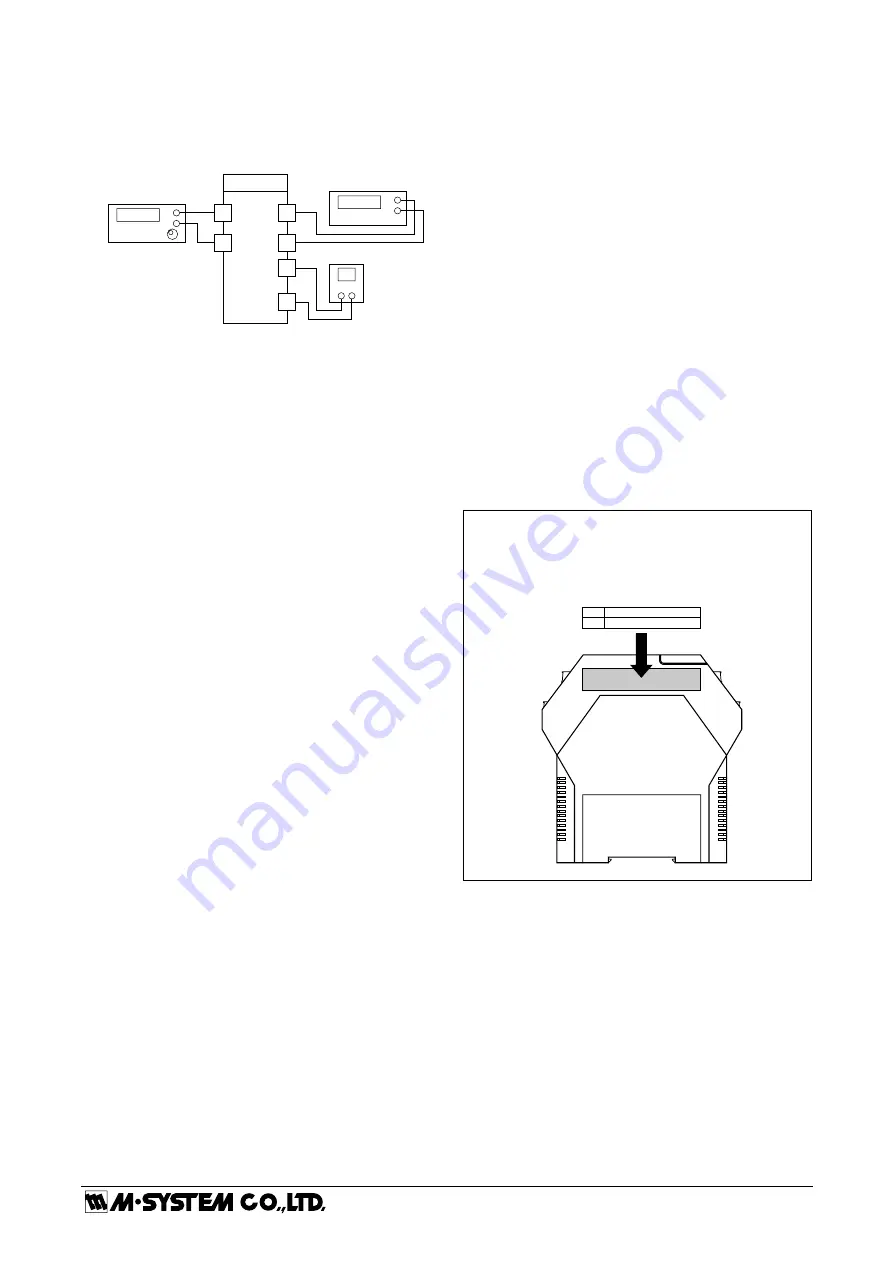
M3LDY
P. 6 / 7
EM-2664-A
5-2-55, Minamitsumori, Nishinari-ku, Osaka 557-0063 JAPAN
Phone: +81(6)6659-8201 Fax: +81(6)6659-8510 E-mail: [email protected]
■
PREPARATION (e.g. M3LDY-R/A)
1) Mount the DIP-SW-configured M3LDY on to a DIN rail.
2) Connect the M3LDY to a simulator and a multimeter
and to a DC power source as shown below.
3) Turn the power supply on and wait for 10 minutes.
2
3
7
8
11
12
M3LDY
Multimeter
Simulator
+
–
DC Power Source
+ –
+
–
■
INPUT & OUTPUT RANGING
[Example]
Setting input to 4 – 20mA DC and output to 1 – 5V DC
1) Run Mode: Confirm that the green LED is blinking
(model M3LDY-x/A) or the green LED turns on (model
M3LDY-x/B).
2) Input Configuration Mode: Press MODE button for long-
er than 5 seconds until the LD1 red LED is ON and the
LD2 red LED is blinking.
3) 0% Input Ranging: Apply the desired minimum input
level (e.g. 4mA) from the simulator and push DOWN but-
ton until the LD1 blinks for approx. 2 sec. and then turns
OFF. When you release the button, the LD1 is returned
to ON.
The blinking LD1 means that the value is stored in the
memory. If the LED does not change, the entered level
may be inappropriate: too small a span, or out of usable
range (same for all steps).
4) 100% Input Ranging: Apply the desired maximum input
level (e.g. 20mA) from the simulator and push UP button
until the LD1 blinks for approx. 2 sec. and then turns
OFF. When you release the button, the LD1 is returned
to ON.
5) Output Configuration Mode: Push MODE button and
confirm that the LD3 red LED instead of LD2 is blinking.
6) 0% Output Ranging: Increase or decrease the simulated
input until the meter shows the desired minimum out-
put level (e.g. 1V). Push DOWN button until the LD1
blinks for approx. 2 sec. and then turns OFF. When you
release the button, the LD1 is returned to ON.
7) 100% Output Ranging: Increase or decrease the simu
-
lated input until the meter shows the desired maximum
output level (e.g. 5V). Push UP button until the LD1
blinks for approx. 2 sec. and then turns OFF. When you
release the button, the LD1 is returned to ON.
8) Run Mode: Programming complete, push MODE button
and confirm that only the LD1 green LED is blinking.
■
ZERO & SPAN ADJUSTMENTS
After the transmitter is installed and operational, fine zero
and span tuning can be performed as explained below. Both
zero and span are adjustable within ±15%.
1) Run Mode: Confirm that the green LED is blinking
(model M3LDY-x/A) or the green LED turns on (model
M3LDY-x/B).
2) Fine Zero Calibration Mode: Press MODE button for 1
or 2 seconds until the LD1 red LED is ON and the LD2
green LED is blinking.
3) Use UP (increase) and DOWN (decrease) buttons to ad-
just the output to 0%.
4) Fine Span Calibration Mode: Push MODE button and
confirm that the LD3 green LED instead of LD2 is blink-
ing.
5) Use UP (increase) and DOWN (decrease) buttons to ad
-
just the output to 100%.
6) Run Mode: Push MODE button and confirm that only the
LD1 green LED is blinking.
Note 1: Calibration steps can be skipped when not needed
by repeating pushing MODE buttons.
Note 2: There is no stated order of setting 0% and 100%
levels or no limitation of entering values for multiple times
within one step of Calibration Mode. Signal level is stored
each time the respective UP or DOWN button is pressed.
■
I/O RANGE LABEL
Blank I/O range labels are included in the product pack-
age. Write in the configured ranges and put the label on
the side as shown below.
INPUT
OUTPUT
I/O Range Label (included in the product package)

























